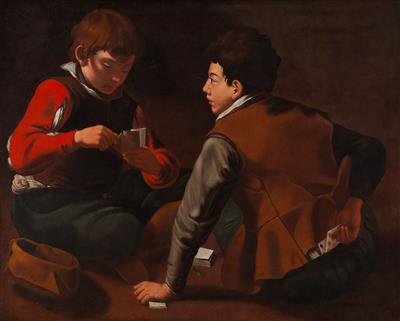Circle of Michelangelo Merisi, called il Caravaggio

(Milan 1571–1610 Porto Ercole)
The Cardsharps, fraud,
oil on canvas, 97 x 120.5 cm, framed
Provenance:
Private collection, Northern Italy
Literature:
M. Marini, Io, Michelangelo da Caravaggio, Rome 1974, p. 471, R-15 (mentioned), illustrated (as Pensionante del Saraceni);
B. Nicolson, The International Caravaggesque Movement: Lists of Pictures by Caravaggio and his Followers through Europe from 1590 to 1650, Oxford 1979, pp. 38-39 (mentioned, as probably by an artist from southern Spain, circa 1620; close to the young Velázquez);
B. Nicolson, Caravaggism in Europe, Turin 1990, vol. I, pp. 91 (mentioned, as probably South Spanish, circa 1620; affinities with young Velázquez)
This painting, likely the pendant to lot 312. The subject revisits the famous iconography of the Cardsharps (‘i bari’) likely first introduced by Caravaggio in the work now in the Kimbell Art Museum, Fort Worth. From the beginning of the second decade of the seventeenth century this compostion gained great popularity. In contrast to Caravaggio’s prototype in which the figures are richly dressed and play at a table covered by a precious Persian carpet, in the present painting, the theme is transposed to a much more humble setting. Here, all contextual reference is eliminated and the two youths, who appear to be scugnizzi – or urchins – from the streets of Rome, are seated directly on the earthen ground.
Another version of the present painting is conserved in the Fogg Art Museum, Cambridge, Massachusetts, which Berenson’s attributed to Caravaggio (see: B. Berenson, Del Caravaggio, delle sue incongruenze e della sua fama, Florence 1951, pp. 17-18 and fig. 14). It was included in Angela Ottino della Chiesa’s 1967 catalogue of Merisi’s works (see: L’opera completa del Caravaggio, Milan 1967, p. 86, no. 8) only to be subsequently considered the work of a follower, by among others, Maurizio Marini (1974). For the first time Marini also published the present Card Players as a replica by the same artist and he attributed these two works within the corpus given to the ‘Pensionante del Saraceni’, who was active around the second decade of the seventeenth century. This artist was given this pseudonym by Roberto Longhi on account of the close stylistic similarities he identified with the works of the Venetian, Carlo Saraceni. The attribution was suggested by these work’s suspended atmosphere and their ‘archaic charm’ [‘arcaico fascino’], as well as by the fact that there were indeed two versions of the same subject: this is a reoccurring trait in the work of the Pensionante, who frequently replicated his own works, as is the case for example, with the celebrated Denial of Saint Peter (respectively in the Pinacoteca Vaticana, Rome and the National Gallery of Ireland, Dublin).
17.10.2017 - 18:00
- Estimate:
-
EUR 80,000.- to EUR 120,000.-
Circle of Michelangelo Merisi, called il Caravaggio
(Milan 1571–1610 Porto Ercole)
The Cardsharps, fraud,
oil on canvas, 97 x 120.5 cm, framed
Provenance:
Private collection, Northern Italy
Literature:
M. Marini, Io, Michelangelo da Caravaggio, Rome 1974, p. 471, R-15 (mentioned), illustrated (as Pensionante del Saraceni);
B. Nicolson, The International Caravaggesque Movement: Lists of Pictures by Caravaggio and his Followers through Europe from 1590 to 1650, Oxford 1979, pp. 38-39 (mentioned, as probably by an artist from southern Spain, circa 1620; close to the young Velázquez);
B. Nicolson, Caravaggism in Europe, Turin 1990, vol. I, pp. 91 (mentioned, as probably South Spanish, circa 1620; affinities with young Velázquez)
This painting, likely the pendant to lot 312. The subject revisits the famous iconography of the Cardsharps (‘i bari’) likely first introduced by Caravaggio in the work now in the Kimbell Art Museum, Fort Worth. From the beginning of the second decade of the seventeenth century this compostion gained great popularity. In contrast to Caravaggio’s prototype in which the figures are richly dressed and play at a table covered by a precious Persian carpet, in the present painting, the theme is transposed to a much more humble setting. Here, all contextual reference is eliminated and the two youths, who appear to be scugnizzi – or urchins – from the streets of Rome, are seated directly on the earthen ground.
Another version of the present painting is conserved in the Fogg Art Museum, Cambridge, Massachusetts, which Berenson’s attributed to Caravaggio (see: B. Berenson, Del Caravaggio, delle sue incongruenze e della sua fama, Florence 1951, pp. 17-18 and fig. 14). It was included in Angela Ottino della Chiesa’s 1967 catalogue of Merisi’s works (see: L’opera completa del Caravaggio, Milan 1967, p. 86, no. 8) only to be subsequently considered the work of a follower, by among others, Maurizio Marini (1974). For the first time Marini also published the present Card Players as a replica by the same artist and he attributed these two works within the corpus given to the ‘Pensionante del Saraceni’, who was active around the second decade of the seventeenth century. This artist was given this pseudonym by Roberto Longhi on account of the close stylistic similarities he identified with the works of the Venetian, Carlo Saraceni. The attribution was suggested by these work’s suspended atmosphere and their ‘archaic charm’ [‘arcaico fascino’], as well as by the fact that there were indeed two versions of the same subject: this is a reoccurring trait in the work of the Pensionante, who frequently replicated his own works, as is the case for example, with the celebrated Denial of Saint Peter (respectively in the Pinacoteca Vaticana, Rome and the National Gallery of Ireland, Dublin).
|
Buyers hotline
Mon.-Fri.: 10.00am - 5.00pm
old.masters@dorotheum.at +43 1 515 60 403 |
| Auction: | Old Master Paintings |
| Auction type: | Saleroom auction |
| Date: | 17.10.2017 - 18:00 |
| Location: | Vienna | Palais Dorotheum |
| Exhibition: | 07.10. - 17.10.2017 |
